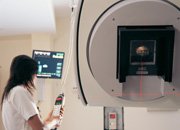Advertisment
ASCO 2012 Report – Radiation in childhood cancer increases risk of breast cancer

by Marybeth Burke – Women treated for childhood cancer with chest radiation therapy have a high risk of developing breast cancer at a young age, comparable to that of the BRCA1/2 mutation carriers, according to data released at the American Society of Clinical Oncology Conference (ASCO) in Chicago in June.
Researchers also found that women treated with lower doses of chest radiation (10-19 Gy) also have an elevated risk of breast cancer at a young age, and may warrant screening.
“While radiation doses have decreased and techniques have improved, radiation is still an essential part of therapy for many childhood cancers,” said Chaya S. Moskowitz, Ph.D., study lead author and an associate member and associate attending biostatistician at Memorial Sloan-Kettering Cancer Center, NY.
“The goal is to maximize the cure rates for childhood cancer while minimizing future health problems. For women treated with 20 Gy or more of chest radiation, the Children’s Oncology Group recommends breast cancer surveillance with an annual mammogram and breast MRI starting at age 25 or 8 years after the radiation (whichever is last). Our results suggest that young women treated with lower doses of radiation who are not currently being screened also have an elevated risk of breast cancer and might benefit from a similar screening strategy,” Dr Moskowitz said.
“These are rather striking data and warrant our careful attention and improved screening. We have an obligation to many thousands of women we treated many years ago,” said Nicholas Vogelzang, MD, Chair of ASCO’s Cancer Communications Committee and Chair and Medical Director, Developmental Therapeutics Committee, US Oncology, Comprehensive Cancer Centers of Nevada.
Study Design and Results
Researchers evaluated the risk of breast cancer (BC) in a cohort of 1268 female 5-year childhood cancer survivors treated with chest radiation therapy (RT) and estimated the cumulative incidence of BC non-parametrically treating death as a competing risk, according to abstract #9513.
The cumulative incidence of BC in BRCA 1/2 mutation carriers was estimated with the kin-cohort method using data from 4570 female first-degree relatives of women diagnosed with unilateral BC (probands) participating in the WECARE study. Absolute Excess Risks (AERs) were estimated using population-based data from the SEER programme.
With a median follow-up of 26 years (range 5-39) for the CCSS cohort on 175 women were diagnosed with BC at a median age of 38 years (range 24-53) and a median latency of 23 years (range 7-38); the overall cumulative incidence of BC by age 50 was 24% and among Hodgkin lymphoma survivors was 30%. In comparison, among first-degree relatives of WECARE Study probands 324 were diagnosed with BC (median age at diagnosis, 55 years (range 26-90).
The estimated cumulative incidence by age 50 was 31% and 10% in carriers of BRCA1 and BRCA2 mutations respectively, according to the study. The population cumulative incidence of BC is 4% by age 50. Among the childhood cancer survivors, AERs for BCs diagnosed per 10,000 person-years of observation were respectively 34, 27, and 95 among women treated with 10-19 Gy (23%), 20-29 Gy (17%) and 30+Gy (56%) of chest RT.
“Women treated for childhood cancer with chest RT have a substantial risk of BC comparable to BRCA1/2 mutation carriers and considerably greater than that of the general population. Women treated with 10-19 Gy RT had an increased excess risk warranting consideration of breast cancer surveillance strategies similar to the current recommendation for women treated with >20Gy,” researchers concluded.





